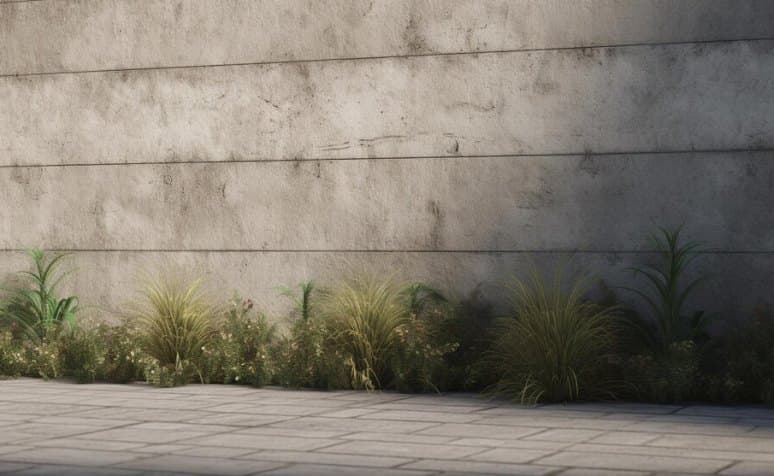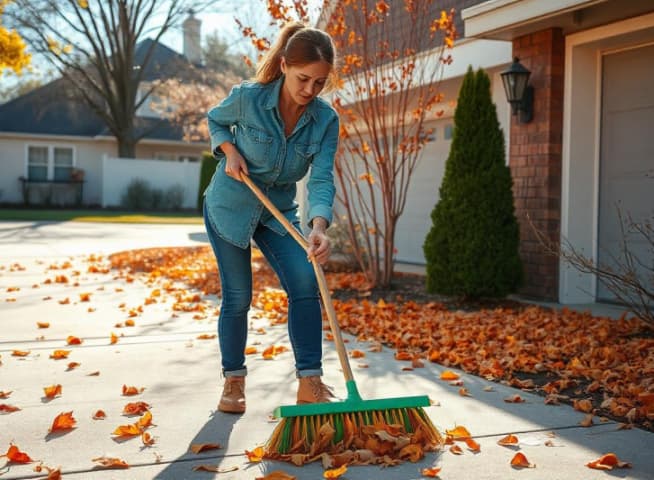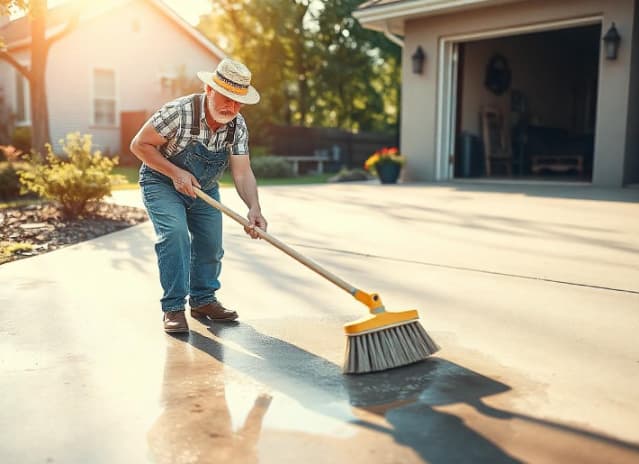Cleaning concrete surfaces without a pressure washer is entirely possible and can still produce excellent results. Whether you’re cleaning your driveway, patio, sidewalk, or pool area, there are several methods and tools you can use to effectively remove dirt, stains, and debris.
Despite being widely utilized for deep cleaning, pressure washers aren’t always required or even the ideal choice in every circumstance. Pressure washers can be expensive, require experience to use correctly, and may damage delicate surfaces if not handled properly.
Fortunately, there are effective alternative methods to clean concrete using simple household tools and cleaning solutions.
We’ll look at useful, affordable alternatives to pressure washing concrete in this post. Whether you’re dealing with stubborn stains, grease spots, or general grime, these methods will help restore the appearance of your concrete surfaces with minimal effort.
Why Does Concrete Get So Dirty?
Concrete is a porous material, meaning it easily absorbs dirt, oil, and other contaminants. Several factors contribute to the accumulation of grime on concrete surfaces:
- Weather Exposure: Rain, snow, and humidity promote mold, mildew, and algae growth.
- Vehicle and Foot Traffic: Cars leak oil and fluids, while shoes track dirt, dust, and debris.
- Environmental Pollutants: Airborne particles, industrial pollution, and organic matter settle on concrete over time.
- Natural Debris: Leaves, bird droppings, and tree sap stain and discolor the surface.
- Lack of Maintenance: Without regular cleaning, these contaminants build up, leading to stubborn stains and discoloration.
Read Also: How to Remove Fake Snow from Windows
How to Clean Concrete Without a Pressure Washer
Here’s a step-by-step guide to cleaning concrete without relying on a pressure washer.
1. Sweep or Remove Loose Debris
Start by clearing the surface of any loose dirt, leaves, twigs, or other debris. This will prevent dirt from getting ground into the concrete when you clean.
You can use a broom, a push broom, or a dustpan to gather the debris. Alternatively, you can use a leaf blower to make the job quicker and more efficient, especially for larger areas.
2. Rinse the Surface with Water
Once the debris is cleared, rinse the concrete surface with water. You can use a garden hose to wet the surface, which will help loosen dirt and grime. Make sure to cover the entire surface evenly, as this will make it easier to clean.
3. Use a Cleaning Solution
Depending on the type of dirt or stains you’re dealing with, you can make a cleaning solution. Here are a few options for common types of concrete stains:
- Mild Cleaning Solution: For general dirt and grime, mix warm water with a few drops of dish soap or a pH-balanced cleaner.
- Vinegar Solution: For light stains, mix one part white vinegar with four parts water. Vinegar is an effective natural cleaner and can help lift grime and some mild stains.
- Baking Soda Paste: For tougher stains, make a paste using baking soda and water. Apply this paste directly to stains and allow it to sit for 15-30 minutes before scrubbing.
- Degreaser: For oil or grease stains, use a concrete degreaser. These can be purchased at most hardware stores and are designed to break down stubborn oils.
4. Scrub the Concrete
After applying the cleaning solution, use a stiff-bristled brush or a long-handled scrub brush to scrub the concrete. Work in small sections to ensure you cover the entire surface.
For tougher stains, you may need to apply extra cleaning solution or scrub more vigorously. Be sure to focus on areas with visible stains or dirt buildup.
If you are cleaning a large surface, you can use a floor mop with a scrubbing head or a microfiber mop to make the job easier. You can also use a push broom for larger areas to ensure even scrubbing.
5. Let the Cleaning Solution Sit (Optional)
For stubborn stains, it can be helpful to let the cleaning solution sit for 10-15 minutes before scrubbing. This will give the solution more time to break down the dirt, grease, or stain. Just make sure the cleaning solution doesn’t dry on the surface before you scrub it off.
6. Rinse Again
After scrubbing, rinse the concrete thoroughly with water from your hose. Make sure to wash away all the soap, vinegar, or cleaning solution to avoid leaving a residue behind.
It’s important to ensure the surface is fully rinsed, especially if you used any cleaning agents like vinegar or degreasers.
7. Tackle Tough Stains
If stains persist after cleaning, you can try additional methods for more stubborn stains:
- Oil Stains: For oil stains, sprinkle some baking soda or cat litter over the stain and let it sit for a few hours. Then, scrub the area again with a stiff brush.
- Rust Stains: For rust stains, mix equal parts of lemon juice and baking soda to create a paste. Apply it to the rust stain and let it sit for 10-15 minutes before scrubbing.
- Mold or Mildew: If you notice mold or mildew, you can use a mixture of bleach and water (1 part bleach to 4 parts water). Apply the solution to the affected area and scrub with a brush.
8. Dry the Concrete
Once you’ve rinsed the concrete and removed all cleaning solutions, allow the surface to air dry. You can also use towels or mops to help dry the surface more quickly, especially in areas that may have excess water pooling.
9. Seal the Concrete (Optional)
After cleaning, consider applying a concrete sealer to protect the surface from stains and make future cleaning easier. Concrete sealers create a barrier that helps prevent dirt, moisture, and stains from penetrating the surface. Follow the instructions on the sealer product to apply it properly.
Conclusion
Maintaining clean concrete surfaces without a pressure washer is both achievable and practical. By using household ingredients like vinegar, baking soda, or detergent, along with manual scrubbing and soaking techniques, you can effectively remove dirt and stains.
For tougher grime, commercial concrete cleaners provide an extra boost. This method offers a more economical and environmentally responsible option, but it also takes more time and effort. With consistent care and preventive measures, your concrete surfaces can stay fresh and well-maintained without the need for high-pressure equipment.


